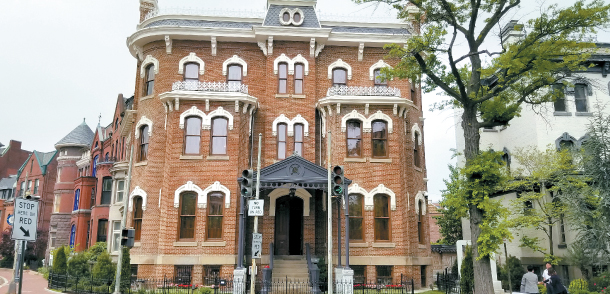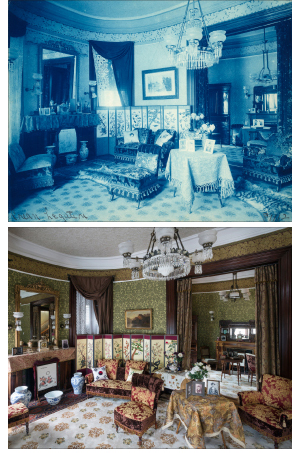Korea’s first American home reopens its doors : The building was sold by Japan in 1910, but repurchased in 2012

The Old Korean Legation in Washington will open to the public on Tuesday. It was owned by private owners until 2012. The building returned to Korea 102 years after it was sold by the Japanese government in 1910. [OVERSEAS KOREAN CULTURAL HERITAGE FOUNDATION]
The Old Korean Legation building used to house Joseon (1392-1910) diplomats to the U.S. from 1889 to 1905, but was sold to the Japanese government for $5 in 1910, which immediately sold it off to a private U.S. owner named Horace K. Fulton for $10 just minutes later on the same spot. It took the Korean government 102 years to buy it back at a price of $350,000 in 2012, when it began a six-year renovation. After careful research of old photographs and documents, the heritage administration restored the building to the way it used to stand a century ago. The renovation was complete on March 12.
JoongAng Ilbo, an affiliate of the Korea JoongAng Daily, visited the building on May 14, prior to the opening which will take place on Tuesday morning. Aside from the new street signs and traffic lights that have been installed, there seemed almost no difference in the scenery from the photograph that was taken in 1893. The front gate has been painted in navy with a Taeguk mark just as was so in the past. New features that have been added to the building include a garden with flower beds, which have been renovated from a parking lot.

The Old Korean Legation building has been renovated based on photographs and documents from the past, such as photographs of the building taken in 1893, left. The reception room has been restored as closely as possible to the past, as can be seen in a picture taken this month, right. [OVERSEAS KOREAN CULTURAL HERITAGE FOUNDATION]
Park Chung-yang, the first Korean diplomat to the United States, had to stay in a private house on 15th Street from 1888 and 1889, the years he was dispatched to the U.S., and therefore the second diplomat Yi Ha-young became the first person to be housed in the legation building in 1889. Yi used to be the royal doctor to King Gojong (1852-1919) and also the interpreter for Horace Allen, the first American Protestant missionary to Korea. Park and Yi carried out secret missions given by the King for the independence of Joseon under Japanese Colonial rule: Park had met with President Grover Cleveland to pass on a secret document from King Gojong and Yi held extravagant parties to lobby the U.S. government to dispatch their army to Korea.
The third diplomat was the defamed Ye Wanyong, a pro-Japanese minister who signed the Eulsa Treaty of 1905, also known as the Japan-Korea Protectorate Treaty of 1905, which robbed the Joseon Dynasty of all its diplomatic powers. The fourth diplomat Yi Chae-yeon came back to Korea and built a rotary in central Seoul, which later became Seoul Plaza in front of Seoul’s City Hall.
Opening the steel front doors, the kitchen sits on the right side with a large-sized Taegukgi (Korean flag) hanging on the entrance, and a colorfully decorated reception room sits on the left. With silk chairs and sofas, a folding screen and cushions embroidered with the Taeguk mark, the reception room has been set up as it had been before it exchanged hands, with photographs of the ninth diplomat Yi Beom-jin’s family set up on the table. The third floor has been turned into an exhibit hall to show the history of Korea and the building.
The legation building was shut down in 1905 after the Eulsa Treaty, and used for various means after it was sold by the Japanese government in 1910 to a private owner. The Cultural Heritage Administration, upon hearing the news, worked to bring the building back to the Korean people in 2003 to coincide with the 100th year of the first official immigration to the United States.
“The legation building is meaningful in that it symbolizes the independent ideology of King Gojong, who tried to open up a broader diplomatic horizon,” said the Cultural Heritage Administration in a press release. “Also, its cultural value is very high in that it is the only legation of the Korean Empire which still keeps its exterior the same as it was in the past.”
“Park Bo-kyon of the JoongAng Ilbo visited the site over 20 times to write articles, columns and books to emphasize the historical meaning of the building and independent diplomacy, thereby contributing to getting the building back,” said O Soo-dong, secretary-general of Overseas Korean Cultural Heritage Foundation.
Reporter Park received an order of the civil merit in 2013 for his contribution.
The building will be open to the public every day except for Mondays, from 10 a.m. to 5 p.m., for free. Staff members will speak both Korean and English. Reservations can be made both on-site and online, at www.oldkoreanlegation.org.
BY JUNG HYO-SIK, YOON SO-YEON [yoon.soyeon@joongang.co.kr]
5달러에 뺏긴 대한제국공사관, 113년 만에 태극기 날린다
미국 워싱턴 DC 백악관에서 북동쪽으로 약 1.4㎞ 로건서클의 위쪽 출구에 빅토리아 양식의 지하 1층, 지상 3층 붉은 벽돌 건물이 서 있다. 13번가 1500번지. 1889년 구한말 외교관들이 처음 입주했던 130년 전 모습 그대로 복원한 주미 대한제국공사관이다. 1910년 일제에 단돈 5달러에 빼앗긴 건물을 2012년 350만 달러에 환수해 6년에 걸쳐 철저한 고증과 원형 복원공사를 마쳤다. 오는 22일 근대 대미 외교를 상징하는 역사유적 기념관으로 정식 개관한다.
14일(현지시간) 미리 찾은 공사관은 건물 앞 교통신호등과 표지판을 제외하면 옛날 사진과 차이를 발견하기 힘들었다. 태극 문양이 새겨진 감색 철제 현관도 그대로 재현됐다. 건물 오른편 주차장 터엔 꽃담과 불로문을 세우고 박석을 놓아 작은 한국식 정원을 새로 조성했다.
공사관엔 힘없는 소국 조선의 좌절과 망국의 회한(悔恨)이 서려 있다. 1888년 1월 초대 공사 박정양은 부임 당시엔 '피셔 하우스'라고 불리는 인근 15번가 일반 주택에 세들어 살았다. 박 공사는 조선의 자주 외교를 막으려던 청나라의 압박에도 스티븐 클리블랜드 대통령을 단독 접견해 고종의 국서를 전달한 것이 빌미가 돼 이듬해 위안스카이에 의해 소환당했다. 그 뒤 2대 서리공사 이하영이 현재의 공사관으로 옮겼다. 고종은 조선의 자주성을 보이려고 1891년 당시 황실 자금인 내탕금의 절반인 2만5000달러를 들여 공사관 건물을 사들였다. 해외 공관 중 유일한 조선 정부 소유 건물이었다.
철제 지붕이 있는 현관을 지나 돌계단을 걸어 올라가면 오른쪽 식당 입구에 대형 태극기가 걸려 있고, 왼쪽으론 비단 의자와 소파, 병풍, 태극 문양의 쿠션이 화려하게 꾸며진 접견실이 나타난다. 그곳 탁자 위엔 9대 공사인 이범진 부부와 차남 이위종의 어린 시절 모습의 사진이 놓여 있다. 이위종은 1896년 부임한 아버지와 함께 워싱턴에 와서 초등학교에 다녔고, 아버지가 백악관·국무부를 오갈 때 통역 역할도 했다고 한다. 그가 11년 후 1907년 이준·이상설 열사와 함께 헤이그 특사로 파견됐던 것도 유창한 외국어 실력 때문이었다.
2대 이하영은 고종의 어의(御醫)이자 초대 박 공사의 미 정부 안내 역활을 맡았던 호러스 알렌의 통역 출신이었다. 초대 박 공사와 다른 공관원이 소환당하자 일약 공사에 올랐다. 그는 조선에서 청나라 세력을 몰아내기 위해 미국의 파병을 성사시키라는 고종의 밀명을 받아 움직였다. 미 정계 파병 로비를 위해 거액의 차관을 얻어 공관에서 연일 성대한 연회를 열기도 했다. 클리블랜드 대통령의 부인 프랜시스가 처음으로 해외 공관 연회에 참석한 모습은 당시 언론에 대서특필됐다. 하지만 미국 정부는 고립주의인 먼로주의 노선에 따라 고종의 요청을 거절했다. 고종의 계획은 수포로 돌아갔지만 덕분에 이하영은 미국 사교계 스타 반열에 오른 최초의 한국인이 됐다. 3대 공사는 이완용이었다. 4대 공사이자 이후 한성판윤을 오래 지낸 이채연은 매일 본 공관앞 로건서클을 본따 한성부(시청) 앞에 로터리를 만들었다. 이게 서울광장의 원형이다.
1905년 을사늑약으로 외교권을 잃으며 공관은 폐쇄됐다. 1910년 경술국치(庚戌國恥) 3일 뒤 우치다 야스야(內田康哉) 주미 일본공사는 형식적으로 5달러에 이 건물을 산 다음 그 자리에서 1분 뒤 미국인 호레이스 K 풀턴에게 10달러에 팔았다. 이후 이를 되찾기까지는 100년이 넘는 세월이 필요했다.
오수동 국외소재문화재재단 미국사무소 소장은 “박보균 중앙일보 대기자는 2000년대 초반부터 20여 차례 현장을 방문해 기사, 칼럼, 저서를 통해 공사관의 존재와 독립 외교의 역사적 의미를 소개하며 환수에 기여했다”고 말했다. 이 공로로 박 대기자는 2013년 정부로부터 ‘국민훈장 모란장’을 받았다.
오 소장은 “100여 년 전 외교문서 및 사진, 신문 마이크로필름 등을 토대로 한 철저한 고증작업을 통해 원형대로 복원했다”며 “직원 숙소이던 3층은 대미 외교사와 공사관 역사, 대한제국과 공사관 환수운동을 보여주는 전시관으로 꾸몄다”고 설명했다. 22일부터 휴무인 매주 월요일을 제외하고 매일 오전 10시부터 오후 5시까지 일반인에 무료로 공개된다.
워싱턴=정효식 특파원










with the Korea JoongAng Daily
To write comments, please log in to one of the accounts.
Standards Board Policy (0/250자)